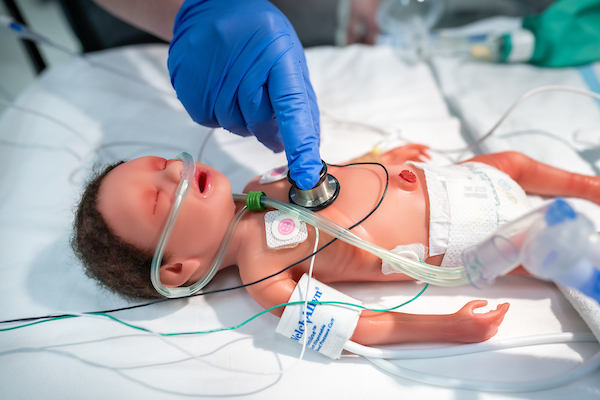Paul, the premature infant simulator from SIMCharacters, is creating realistic training for UF Health staff. Overwhelmingly praised by neonatologists and NICU nurses for his highly realistic anatomy and convincingly lifelike features, the Paul High Emotion simulator has already become Europe’s favorite new manikin. Today Tyler Francischine, writer at UF Health, shares about the exciting new level of hyper realistic neonatal training that Paul allows the UF Health healthcare teams to practice.
His skin turns blue when he needs oxygen; his abdomen becomes distended. He even cries out in pain. He may be made of synthetic materials, but Paul, the premature infant simulator, produces an authentic experience for those who train with him.
Tom LeMaster, director of operations for the UF Center for Experiential Learning and Simulation, says Paul — who traveled to Gainesville from Austria in November — will be used regularly in the UF Health Neonatal Intensive Care Unit, or NICU, for in situ trainings, in which staff who regularly work together participate in a healthcare simulation training in the real patient environment. Paul was acquired by the UF Center for Experiential Learning and Simulation and the UF division of neonatology.
“We’re able to provide this clinical simulation training to the staff that is on duty at that time. These are the people on the front lines,” Lemaster says. “When we’re in their environment, the medical simulation is more realistic, and the patient is treated as a real patient within a couple minutes. It’s an especially immersive experience to train with Paul.”
That’s because Paul is as anatomically accurate as a living, premature baby born at 27 weeks gestation. Measuring just under 14 inches long and weighing a little over 2 pounds, Paul has a 3-D printed larynx based on real, preterm MRI scans and physiological and pathological breathing patterns. Produced by the Austrian company SIMCharacters, Paul is referred to as a high-fidelity simulator for his ability to react visually and aurally to the care he’s given. A stethoscope made especially for Paul allows those training with him to measure his breathing patterns, heart beat and the sounds in his stomach.
“Paul adds realism to the unique challenges around a pre-term baby,” LeMaster says. “Before Paul, there hasn’t been a premature infant simulator as good as this.”
LeMaster says the staff and students who train with human patient simulators like Paul gain skills in teamwork and communication during a crisis, but the hospital as a whole benefits from the regular testing of its equipment and systems.
“With in situ trainings with simulators, we’re often looking for latent safety threats. It may be a systems, process or equipment issue that surfaces in the training that could affect a patient. When we identify and fix those issues during a training, that’s an incredible opportunity,” LeMaster says.
UF Health neonatologist Nicole Cacho, D.O., M.P.H., has trained with Paul in the UF Health NICU, and she says the mannequin’s realistic conditions provide critical training for low-frequency, high-risk situations.
“Very low birth weight babies like Paul comprise only 15-20% of our admissions to the UF Health NICU,” Cacho says. “These babies are at a high risk for long-term medical complications, and they require specific and skilled team resuscitation. Since these cases aren’t seen frequently, giving Paul specific and skilled care in the simulated patient environment helps us to make sure we perform these neonatal resuscitations accurately.”
More About Paul from SIMCharacters
Measuring only 35cm long and weighing less than 1000g, Paul is the most accurate recreation of a preterm baby born in the 27th week of pregnancy. Overwhelmingly praised by neonatologists and NICU nurses for his highly realistic anatomy and convincingly lifelike features, the Paul High Emotion simulator has already become Europe’s favorite new manikin. Designed specifically to improve the realism and learning outcomes of your NICU/PICU training program, Paul will transform your simulations beyond high fidelity into high emotion. Learn
Current preterm simulators do not do enough to convey realistic patient experiences, leaving your participants to imagine a high fidelity relationship which minimizes their learning opportunity. Research has shown that more realistic simulators provide improved learning outcomes – and with 1 in every 10 births being preterm – shouldn’t your specialized department be the most prepared possible? Paul moves beyond high fidelity with new technologies never seen before in healthcare simulation… even in adult sized patient manikins. With Paul, SIMCharacters is taking the next step in the future of medical simulation. High fidelity was yesterday – the future belongs to High Emotion Simulation. Paul was designed specifically to improve the realism and learning outcomes of your NICU team and will forever change the way neonatology trains.
Read the Full Article on the UFL Website…
&
Learn More About Paul From SIMCharacters!
Today’s article was guest authored by Tyler Francischine, Writer at UF Health. Before joining the UF Health staff in 2016, Tyler regularly contributed to The Gainesville Sun and Gainesville Magazine. She graduated from the University of Florida in 2011 with a bachelor’s degree in journalism. She now contributes to UF College of Medicine publications such as the Florida Physician magazine and Dr. Gator newsletter, as well as alumni features, news releases and copy for special publications.
Have a story to share with the global healthcare simulation community? Submit your simulation news and resources here!









